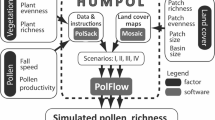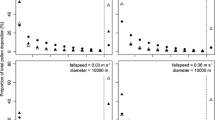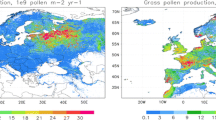Abstract
Models of atmospheric dispersal of anemophilous pollen are important tools in Quaternary plant ecology for determining pollen-source areas and for applying distance-weightings to vegetation data in formal pollen-vegetation calibrations. The most widely applied model is Prentice’s model, which uses a modified form of Sutton’s equation for atmospheric diffusion to predict pollen-source areas from size of the depositional basin and a set of depositional parameters (deposition velocity of the pollen grains and mean wind speed) and atmospheric parameters (turbulence parameter, vertical diffusion coefficient). We review the physical theory underlying Sutton’s equation and Prentice’s model, explore the effects of different values of the depositional and atmospheric parameters on model predictions, and provide prescriptions for model application, parameter specification, and further research on pollen dispersal. Most applications of the models to pollen dispersal have assumed neutral atmospheric conditions. We argue that most pollen dispersal takes place in unstable atmospheric conditions, and prescribe appropriate values for the atmospheric parameters for unstable conditions. Our simulations using these parameters indicate more widespread pollen dispersal from a source than under neutral conditions. We review available data sets for sedimentation velocity of pollen grains, and compare the measured estimates with sedimentation velocities predicted from Stokes’s Law to assess validity of the data. Substantial variability exists among data sets, but several are suitable for application to pollen-dispersal models. Finally, we discuss aspects of release, dispersal, and deposition of anemophilous pollen that are in need of further theoretical and empirical study. Such studies will contribute not only to Quaternary plant ecology but also to understanding of pollination biology, population genetics, and functional morphology of pollen grains and pollen-bearing organs.
Zusammenfassung
Modelle für die atmosphärische Verteilung windverbreiteten Pollens sind wichtige Werkzeuge der Quartär-Pflanzenökologie zur Bestimmung von Polleneinzugsgebieten und um bei der mathematischen Kalibrierung des Zusammenhangs zwischen Pollen und Vegetation die Gewichtung von Entfernungen auf Vegetationsdaten anzuwenden. Das am häufigsten angewendente Modell ist das von Prentice, das eine angepaßte Form von Suttons Gleichung für atmosphärische Diffusion benutzt um Polleneinzugsgebiete auf Grundlage der Größe des Ablagerungsbeckens und einer Reihe von Ablagerungsparametern (Sinkgeschwindigkeit, vertikaler Diffusionskoeffizient) vorauszusagen. Wir besprechen die physikalische Theorie, die hinter Suttons und Prentices Modell steht, untersuchen, welchen Einfluß Ablagerungsparameter unterschiedler Größe sowie die atmosphärischen Parameter auf die Modellvorhersagen haben und geben Empfehlungen für die Anwendung der Modelle, Spezifizierung der Parameter und weiterführende Forschung zur Pollenverbreitung. Die meisten Anwendungen von Modellen zur Pollenausbreitung gehen von neutraler thermischer Schichtung aus. Wir erörtern, daßein Großteil der Pollenablagerung unter unstabilen Schichtungsverhältnissen stattfindet und beschreiben angemessene Werte für die atmosphärischen Parameter unter unstabilen Schichtungsverhältnissen. Unsere Simulationen, die diese Parameter benutzen, deuten darauf hin, daß eine weitere Pollenausbreitung von der Quelle aus stattfindet als bei neutraler Schichtung. Wir überprüfen verfügbare Datensätze zur Sinkgeschwindigkeit von Pollenkörnern und vergleichen die gemessenen Werte mit den Fallgeschwindigkeiten, die von Stokes Gesetz vorhergesagt werden, um die Richtigkeit der Daten zu beurteilen. Zwischen den Datensätzen bestehen beträchtlichte Unterschiede, aber einige sind für die Anwendung auf Pollenausbreitungs-Modelle geignet. Scließlich diskutieren wir die Aspekte der Freisetzung, Verbreitung und Ablagernug windverbreiteten Pollens, welche weitergehender theoretischer und empirischer Untersuchung bedürfen. Solche Untersuchungen werden nicht nur zur Quartär-Pflanzenökologie, sondern auch zum Verständnis von Bestäubungsbiologie, Populationsgenetik und funktioneller Morphologie von Pollenkörnern und pollentragenden Organen beitragen.
Similar content being viewed by others
Literature Cited
Andersen, S. Th. 1970. The relative pollen productivity and pollen representation of north European trees, and correction factors for tree pollen spectra determined by surface pollen analyses from forests. Danmarks Geol. Undersøl., ser. II, 96: 1–199.
Aylor, D. E. 1975. Deposition of particles in a plant canopy. J. Appl. Meteorol. 14: 52–57.
—. 1978. Dispersal in space and time: aerial pathogens. Pages 159–180in J.G. Horsfall & E.B. Cowling (eds.), Plant disease: an advanced treatise. Volume 2: How disease develops in populations. Academic Press, New York.
—. 1982. Modeling spore dispersal in a barley crop. Agric. Meteorol. 26: 215–219.
—. 1987. Deposition gradients of urediniospores ofPuccinia recondita near a source. Phytopathology 77: 1442–1448.
—. 1989. Aerial spore dispersal close to a focus of disease. Agric. Forest Meteorol. 47: 109–122.
—. 1990. The role of intermittent wind in the dispersal of fungal pathogens. Ann. Rev. Phytopathol. 28: 73–92.
— &F. J. Ferrandino. 1989. Dispersion of spores released from an elevated line source within a wheat canopy. Boundary-Layer Meteorol. 46: 251–273.
— &J.-Y. Parlange. 1975. Ventilation required to entrain small particles from leaves. Pl. Physiol. 56: 97–99.
—,H. A. McCartney &A. Bainbridge. 1981. Deposition of particles liberated in gusts of wind. J. Appl. Meteorol. 20: 1212–1221.
Barad, L. & J. J. Fuquay. 1962. The Green Glow Diffusion Program. Geophysical Research Paper no. 73, Air Force Cambridge Research Laboratory, U.S. Atomic Energy Commission Hanford Report HW-71400.
Bianchi, D. E., D. J. Schwemmin &W. H. Wagner Jr. 1959. Pollen release in the common ragweed (Ambrosia artemisiifolia). Bot. Gaz. 120: 235–243.
Blackmore S. &S. H. Barnes. 1986. Harmomegathic mechanisms in pollen grains. Pages 137–149in S. Blackmore & I. K. Ferguson (eds.), Pollen and spores: form and function. Academic Press, London.
Bodmer, H. 1922. Über den Windpollen. Natur & Techn. 3: 294–298.
Boyer, W. D. 1966. Longleaf pine pollen dispersal. Forest Sci. 12: 367–368.
Brush, G. S. &L. M. Brush. 1972. Transport of pollen in a sediment-laden channel: a laboratory study. Amer. J. Sci. 272: 359–381.
——. 1994. Transport and deposition of pollen in an estuary: signature of the landscape. Pages 33–46in A. Traverse (ed.), Sedimentation of organic particles. Cambridge University Press, Cambridge.
Buell, M. F. 1947. Mass dissemination of pine pollen. J. Elisha Mitchell Sci. Soc. 63: 163–167.
Burrows, F. M. 1975. Calculation of primary trajectories of dust seeds, spores and pollen in unsteady wind. New Phytol. 75: 389–403.
Calcote, R. 1995. Pollen source area and pollen productivity: evidence from forest hollows. J. Ecol. 83: 591–602.
Carter, M. V. 1965. Ascospore deposition inEutypa armeniacae. Austral. J. Agric. Res. 16: 825–836.
Chamberlain, A. C. 1953. Aspects of travel and deposition of aerosol and vapour clouds. Atomic Energy Research Establishment Report HP/R 1261. Harwell, England.
—. 1967a. Deposition of particles to natural surfaces. Pages 138–164in P. H. Gregory & J. L. Monteith (eds.), Airborne microbes. Cambridge University Press, London.
—. 1967b. Transport ofLycopodium spores and other small particles to rough surfaces. Proc. Roy Soc. A 296: 45–70.
—. 1975. The movement of particles in plant communities. Pages 155–203in J. L. Monteith (ed.), Vegetation and the atmosphere. Volume 1. Academic Press, New York.
— &R. C. Chadwick. 1972. Deposition of spores and other particles on vegetation and soil. Ann. Appl. Biol. 71: 141–158.
— &P. Little. 1981. Transport and capture of particles by vegetation. Pages 147–173in J. Grace etal. (eds.), Plants and their atmospheric environments. Blackwells, Oxford.
Colwell, R. N. 1951. The use of radioactive isotopes in determining spore distribution patterns. Amer. J. Bot. 38:511–523.
Crane, P. R. 1986. Form and function in wind dispersed pollen. Pages 179–202in S. Blackmore & I. K. Ferguson (eds.), Pollen and spores: form and function. Academic Press, London.
Curtis, J. D. &N. R. Lersten. 1995. Anatomical aspects of pollen release from staminate flowers ofAmbrosia trifida (Asteraceae). Intl. J. Pl. Sci. 156: 29–36.
Davis, M. B. 1963. On the theory of pollen analysis. Amer. J. Sci. 261: 897–912.
Di-Giovanni, F., P. G. Kevan &M. E. Nasr. 1995. The variability in settling velocities of some pollen and spores. Grana 34: 39–44.
Durham, O. C. 1943. The volumetric incidence of atmospheric allergens. I. Specific gravity of pollen grains. J. Allergy 14: 455–461.
—. 1946. The volumetric incidence of atmospheric allergens. III. Rate of fall of pollen grains in still air. J. Allergy 17: 70–78.
Dyakowska, J. 1936. Researches on the rapidity of the falling down of pollen of some trees. Bull. Acad Polon. Sci. Bl: 155–168.
— &J. Zurzycki. 1959. Gravimetric studies on pollen. Bull. Acad. Polon. Sci. 7: 11–16.
Ebell, L. F. &R. L. Schmidt. 1964. Meteorological factors affecting conifer pollen dispersal on Vancouver Island. Department of Forestry Publication no. 1036. Ottawa, Department of Forestry.
Eisenhut, G. 1961. Untersuchungen über die Morphologie und Ökologie der Pollenkörner heimischer und fremdländischer Waldbäume. Forstwiss. Forsch. 15: 1–68.
Fægri, K &L. van der Pijl. 1979. The principles of pollination ecology. Ed. 3. Pergamon Press, Oxford.
Ferrandino, F. J. &D. E. Aylor. 1984. Settling speed of clusters of spores. Phytopathology 74: 969–972.
Gifford, F. A., Jr. 1968. An outline of theories of diffusion in the lower layers of the atmosphere. Pages 65–116in D. H. Slade (ed.), Meteorology and atomic energy. U.S. Atomic Energy Commission, Oak Ridge, Tennessee.
—. 1976. Turbulent diffusion typing schemes—a review. Nuclear Safety 17: 68–86.
Grace, J &M. A. Collins. 1976. Spore liberation from leaves by wind. Pages 185–198in C. H. Dickinson & T. F. Preece (eds.), Microbiology of aerial plant surfaces. Academic Press, London.
Gregory, P. H. 1973. The microbiology of the atmosphere. Ed. 2. Leonard Hill, Aylesbury.
Hanna, S. R., G. A. Briggs &R. P. Hosker Jr. 1982. Handbook on atmospheric diffusion. DOE/TIC-11223. U.S. Department of Energy, Springfield, VA.
Harrington, J. B., Jr. &K. Metzger. 1963. Ragweed pollen density. Amer. J. Bot. 50: 532–539.
Heathcote, I. W. 1978. Differential pollen deposition and water circulation in small Minnesota lakes. Ph.D. thesis, Yale University, New Haven.
Heslop-Harrison, J. 1979. An interpretation of the hydrodynamics of pollen. Amer. J. Bot. 66: 737–743.
Hesse, M. 1981. The fine structure of the exine in relation to the stickiness of angiosperm pollen. Rev. Palaeobot. Palynol. 35: 81–92.
Islitzer, N. F. &D. H. Slade. 1968. Diffusion and transport experiments. Pages 117–188in D. H. Slade (ed.), Meteorology and atomic energy. TID-24190. U.S. Atomic Energy Commission, Oak Ridge, TN.
Jackson, S. T. 1990. Pollen source area and representation in small lakes of the northeastern United States. Rev. Palaeobot. Palynol. 63: 53–76.
—. 1991. Pollen representation of vegetational patterns along an elevational gradient. J. Veg. Sci. 2: 613–624.
—. 1994. Pollen and spores in Quaternary lake sediments as sensors of vegetation composition: theoretical models and empirical evidence. Pages 253–286in A. Traverse (ed.), Sedimentation of organic particles. Cambridge University Press, Cambridge.
— &J. B. Kearsley. 1998. Representation of local forest composition in moss-polster pollen assemblages. J. Ecol. 86: 474–490.
— &A. Wong. 1994. Using forest patchiness to determine pollen source areas of closed-canopy pollen assemblages. J. Ecol. 82: 89–100.
Jacobson, G. L., Jr. &R. H. W. Bradshaw. 1981. The selection of sites for paleovegetational studies. Quatem. Res. 16: 80–96.
Kabailiene, M. V. 1969. On formation of pollen spectra and restoration of vegetation. Trans. Inst. Geol. Vilnius 11: 1–148.
Knoll, F. 1932. Über die Fernverbreitung des Blütenstaubes durch den Wind. Forschungen und Forstschriffte: Nachrichtenbl. Deutsch. Wiss. Tech. 8: 301–302.
Koski, V. 1970. A study of pollen dispersal as a mechanism of gene flow in conifers. Commun. Inst. Forest. Fenniae 70.4: 1–78.
Legg, B. J. 1983. Movement of plant pathogens in the crop canopy. Phil. Trans., Ser. B 302: 559–574.
— &R. I. Price. 1980. The contribution of sedimentation to aerosol deposition to vegetation with a large leaf area index. Atmosph. Environm. 14: 305–309.
Little, P. 1977. Deposition of 2.75, 5.0 and 8.5 μm particles to plant and soil surfaces. Environm. Pollut. 12: 293–305.
Lovett, G. M. 1981. Forest structure and atmospheric interactions: predictive models for subalpine fir forests. Ph.D. thesis, Dartmouth College, Hanover.
— &W. A. Reiners. 1986. Canopy structure and cloud water deposition in subalpine coniferous forests. Tellus 38B: 319–327.
McCartney, H. A. &B. D. L. Fitt. 1985. Construction of dispersal models. Pages 107–143in C. A. Gilligan (ed.), Advances in plant pathology. Volume 3. Mathematical modeling of crop disease. Academic Press, London.
McNown, J. S. &J. Malaika. 1950. Effects of particle shape on settling velocity at low Reynolds numbers. Amer. Geophys. Union Trans. 31: 74–82.
-, -& H. R. Pramanik. 1951. Particle shape and settling velocity. Intl. Assoc. Hydraulic Res., Fourth Meeting, pp. 511–522.
Niklas, K. J. 1982. Simulated and empiric wind pollination patterns of conifer ovulate cones. Proc. Natl. Acad. Sci. U.S.A. 79: 510–514.
—. 1984. The motion of windborne pollen grains around conifer ovulate cones: implications on wind pollination. Amer. J. Bot. 71: 356–374.
—. 1985. The aerodynamics of wind pollination. Bot. Rev. (Lancaster) 51: 328–386.
— &K. T. Paw U. 1983. Conifer ovulate cone morphology: implications on pollen impaction patterns. Amer. J. Bot. 70: 568–577.
Pande, G. K., R. Pakrash &M. A. Hassam. 1972. Floral biology of barley (Hordeum vulgare L). Indian J. Agric. Sci. 48: 697–703.
Pasquill, F. &F. B. Smith. 1983. Atmospheric diffusion. Ed. 3. Ellis Horwood Limited, Chichester.
Payne, W. W. 1972. Observations of harmomegathy in pollen of Anthophyta. Grana 12: 93–98.
—. 1981. Structure and function in angiosperm pollen wall evolution. Rev. Palaeobot. Palynol. 35: 39–59.
Prentice, I. C. 1985. Pollen representation, source area, and basin size: toward a unified theory of pollen analysis. Quatern. Res. 23: 76–86.
—. 1986. Forest-composition calibration of pollen data. Pages 799–816in B. Berglund (ed.), Hand-book of Holocene palaeoecology and palaeohydrology. John Wiley & Sons, Chichester.
—. 1988. Records of vegetation in space and time: the principles of pollen analysis. Pages 17–42in B. Huntley & T. WebbIII (eds.), Vegetation history. Kluwer Academic, Dordrecht.
Raynor, G. S. 1971. Wind and temperature structure in a coniferous forest and a contiguous field. Forest Sci. 17:351–363.
—,J. V. Hayes &E. C. Ogden. 1974. Particulate dispersion into and within a forest. Boundary-Layer Meteorol. 7: 429–456.
———. 1975. Particulate dispersion from sources within a forest. Boundary-Layer Meteorol. 9: 257–277.
Sarvas, R. 1952. On the flowering of birch and the quality of seed crop. Commun. Inst. Forest. Fenniae 40.7: 1–38.
—. 1962. Investigations on the flowering and seed crop ofPinus sylvestris. Commun. Inst. Forest. Fenniae 53.4: 1–198.
—. 1968. Investigations on the flowering and seed crop ofPicea abies. Commun. Inst. Forest. Fenniae 67.5: 1–84.
Sehmel, G. A. 1980. Particle and gas dry deposition: a review. Atmosph. Environm. 14: 983–1011.
Sharp, W. M. &H. H. Chisman. 1961. Flowering and fruiting in the white oaks. I. Staminate flowering through pollen dispersal. Ecology 42: 365–372.
Silen, R. R. 1962. Pollen dispersal considerations for Douglas-fir. J. Forest. 60: 790–795.
Singer, I. A. &M. E. Smith. 1953. Relation of gustiness to other meteorological parameters. J. Meteorol. 10: 121–126.
——. 1966. Atmospheric dispersion at Brookhaven National Laboratory. Intl. J. Air & Water Pollut. 10: 125–135.
Starr, J. R. 1967. Deposition of particulate matter by hydrometeors. Quart. J. Roy. Meteorol. Soc. 93: 516–521.
Stewart, N. G., H. J. Gale &R. N. Crooks. 1958. The atmospheric diffusion of gases discharged from the chimney of the Harwell Reactor BEPO. Intl. J. Air Pollut. 1: 87–102.
Sugita, S. 1993. A model of pollen source area for an entire lake surface. Quatern. Res. 39: 239–244.
—. 1994. Pollen representation of vegetation in Quaternary sediments: theory and method in patchy vegetation. J. Ecol. 82: 881–897.
Sutton, O. G. 1947a. The problem of diffusion in the lower atmosphere. Quart. J. Roy. Meterol. Soc. 73: 257–281.
—. 1947b. The theoretical distribution of airborne pollution from factory chimneys. Quart. J. Roy. Meterol. Soc. 73: 426–436.
—. 1953. Micrometeorology. McGraw-Hill, New York.
Tauber, H. 1965. Differential pollen dispersion and the interpretation of pollen diagrams. Danmarks Geol. Undersøl., Række 2, Number 89.
Thorne, P. G., G. M. Lovett &W. A. Reiners. 1982. Experimental determination of droplet impaction on canopy components of balsam fir. J. Appl. Meteorol. 21: 1413–1416.
Tomlinson, P. B. 1994. Functional morphology of saccate pollen in conifers with special reference to Podocarpaceae. Intl. J. Pl. Sci. 155: 699–715.
Tonsor, S. J. 1985. Leptokurtic pollen-flow, non-leptokurtic gene flow in a wind-pollinated herb,Plantago lanceolata L. Oecologia 67: 442–446.
Vogel, S. 1981. Life in moving fluids: the physical biology of flow. Princeton University Press, Princeton.
Wang, C.-W., T. O. Perry &A. G. Johnson. 1960. Pollen dispersal of slash pine (Pinus elliottii Engelm.) with special reference to seed orchard management. Silvae Genet. 9: 78–86.
Whitehead, D. R. 1964. Fossil pine pollen and full-glacial vegetation in southeastern North Carolina. Ecology 45: 767–777.
—. 1983. Wind pollination: some ecological and evolutionary perspectives. Pages 97–108in L. Real (ed.), Pollination biology. Academic Press, New York.
Wright, J. W. 1952. Pollen dispersion of some forest trees. United States Forest Service, Northeastern Forest Experiment Station Paper 60.
Author information
Authors and Affiliations
Rights and permissions
About this article
Cite this article
Jackson, S.T., Lyford, M.E. Pollen dispersal models in Quaternary plant ecology: Assumptions, parameters, and prescriptions. Bot. Rev 65, 39–75 (1999). https://doi.org/10.1007/BF02856557
Issue Date:
DOI: https://doi.org/10.1007/BF02856557




